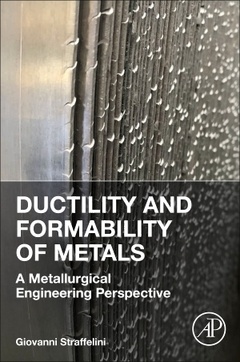Ductility and Formability of Metals A Metallurgical Engineering Perspective
Auteur : Straffelini Giovanni

Ductility and Formability of Metals: A Metallurgical Engineering Perspective uses metallurgical, mechanical and physical principles and concepts to explain ductility while emphasizing the influence of material microstructure on damage mechanisms. Focusing on steel, aluminum, copper, titanium and magnesium alloys, the book examines the strain hardening behaviors of these metals and alloys, the influence of strain rate and temperature, and ductile fracture mechanics. Hot plastic deformation is covered with special consideration given to its interplay with recrystallization phenomena.
Other phenomena such as Dynamic Strain Ageing (DSA) and Adiabatic Shear Banding (ASB) are discussed, and metal working applications such as forging, extrusion and machining are included throughout. Methods for control of ductile cracks in metal parts resulting from rolling, forging, extrusion, drawing, and sheet metal forming are also outlined.
1. Introduction 2. Onset of yielding in metals 3. Strain hardening of metals 4. Plastic deformation: influence of strain rate and temperature (for T<0.4÷0.5 Tm) 5. Plastic deformation at high temperature (T>0.4÷0.5 Tm) 6. Plastic deformation in a triaxial state of stress 7. Mechanisms of plastic damage and ductile fracture 8. Influence of microstructure on ductility 9. Ductility of metals at high temperature 10. Impact testing and ductile to brittle fracture transition 11. Safe plastic forming of metals: General aspects 12. Forging 13. Rolling 14. Extrusion 15. Wire drawing 16. Sheet metal forming operations 17. Working operations by metal removal
- Provides an overview on the plastic deformation behavior and ductile fracture of steel, aluminum, copper, titanium and magnesium alloys
- Illustrates the influence of microstructure on yield behavior, strain hardening of metals, and the influence of strain rate and temperature
- Covers the role of the strain hardening coefficient (n), strain rate index (m), Dynamic Strain Ageing (DSA), and Adiabatic Shear Banding (ASB)
- Metalworking applications are provided throughout, including forging, rolling, extrusion, wire drawing, sheet metal forming and machining
Date de parution : 03-2023
Ouvrage de 444 p.
15.2x22.8 cm


